This document is for the HP Officejet Pro 8500A e-All-in-One printers.
Fixing Print Quality Problems for the HP Officejet Pro 8500A e-All-in-One Printer Series
The quality of a printed document or photo is not as expected. The procedures in this document should help with streaked or faded printouts, color or black ink not printing, documents with blurred or fuzzy text, ink streaks or smears, and other print quality problems.
Some of the following solutions require the full HP software. If you did not install the full software when you installed your printer, click here to go to the software and drivers page, and then download and install the full feature software.
Solution one: Use genuine HP cartridges
HP recommends that you use genuine HP ink or toner supplies. HP cannot guarantee the quality or reliability of non-HP or refilled cartridges. If you do not use genuine HP cartridges, the steps in this document might not resolve the issue. To check the authenticity of your cartridges, go to the HP anti-counterfeit webpage (in English).
Purchase replacement cartridges and other supplies from the HP Store or local retailers.
Solution two: Check the paper
Use the following guidelines to make sure that the paper you are using is appropriate for the print job. If it is not, reload the printer with an appropriate paper type.
-
Load the paper print side down in the input tray. Many papers have printing and nonprinting sides, such as photo paper and envelopes. Usually, the smoother side is the "print side," and sometimes the non-print side has a logo of the paper manufacturer on it.
-
Do not use wrinkled or curled paper. Use only clean, wrinkle-free paper.
-
Use the correct paper type for your project.
-
For everyday text documents, plain paper with ColorLok technology works well. Paper with ColorLok technology is industry-standard paper that works well with HP ink.
-
For documents with dense printing, such as high contrast graphics or photos, use HP Advanced Photo Paper for best results.
-
Some paper might not absorb ink as well as others. If your prints smear easily, make sure you are using a recommended paper.
-
-
Store photo paper in its original packaging inside a resealable plastic bag. Store the paper on a flat surface in a cool, dry place. Load 10-20 sheets of photo paper only when you are ready to print, and then put the unused paper back in the packaging.
-
Try using a different paper. This determines if the problem is related to the paper.
note:Inappropriate paper usually causes vertical streaks in printouts (or if the problem occurs on a copy, dirty scanner glass usually causes the issue). Do not replace cartridges to fix vertical streaks.
|
Examples of horizontal streaks and vertical streaks in printout
|
|
|
Figure : Horizontal streaks in printout
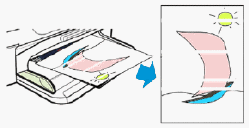
|
Continue with the following troubleshooting steps if your printout contains horizontal streaks, or other print quality issues besides vertical streaks.
|
|
Figure : Vertical streaks in printout
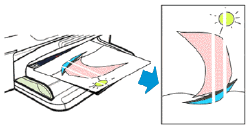
|
Do not replace cartridges for vertical streaks in a printout. Instead, check the paper as described earlier in this document, or search for a document that covers this issue.
|
After trying the preceding guidelines, try to print again.
Solution three: Check the print settings
Follow these steps to check the print settings to make sure that they are appropriate for your print job.
This video shows how to check the print settings on the HP Officejet Pro 8500A All-in-One printer
Step 1: Check the print quality settings
Follow these steps to check the print quality settings.
-
In the software program you are trying to print from, click File, and then click Print. The Print dialog box opens.
-
Select your printer from the Name drop-down menu, and then click Properties. The Properties dialog box opens.
-
Click the Paper/Quality tab.
-
Under Paper Source, select Tray 1 or Tray 2.
-
Review the following options, and then make any necessary changes.
-
Paper sizes: Make sure that the selected option matches your paper size.
-
Media: If one of the options matches your paper type exactly, select that option.
-
Quality Settings: If you are dissatisfied with the quality of your printouts, increase the print quality. To print more quickly, decrease the print quality.
-
-
Click OK, and then click OK again to start the print job.
Step 2: Check the Print in Grayscale setting
Follow these steps to check the grayscale settings.
-
In the software program you are trying to print from, click File, and then click Print. The Print dialog box opens.
-
Select your printer from the Name drop-down menu, and then click Properties. The Properties dialog box opens.
-
Click Advanced.
-
Under Printer Features, check the Print in Grayscale setting.
-
If you are trying to print in color, make sure that the Print in Grayscale setting from the drop-down menu is Off.
-
If you are printing a black-and-white image, select High Quality Grayscale to fix streaking in black areas.
-
-
Click OK, and then click OK again to start the print job.
Solution four: Print and evaluate a Print Quality Diagnostics Page
Follow these steps to print and then evaluate a Print Quality Diagnostics Page. The Print Quality Diagnostics Page helps you determine if the printer needs to be aligned, or if the printheads need to be cleaned, or if the linefeed needs to be calibrated.
Step 1: Print and evaluate a Print Quality Diagnostics Page
Follow these steps to print the Print Quality Diagnostics Page.
-
Load plain white paper into the tray.
-
On the control panel, touch the Right Arrow (
 ) to display the second navigation screen.
) to display the second navigation screen.
-
Touch Setup (
 ).
).
-
Touch the Down Arrow (
 ), and then touch Reports.
), and then touch Reports.
-
Touch Print Quality Report. The Print Quality Diagnostics Page prints.
-
Printer information
-
Test Pattern 1
-
Test Pattern 2
-
Test Pattern 3
Figure : Example of a Print Quality Diagnostics Page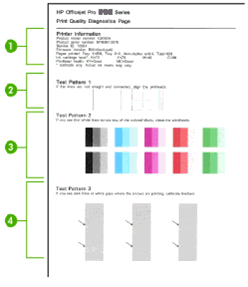
-
-
Do an initial evaluation of the Print Quality Diagnostics Page.
-
If the patterns on the report show no defects, the print mechanism and ink supplies are working correctly. Do not continue with the steps in this solution. Skip to the solution in this document to check the image for further troubleshooting steps.
-
If the patterns on the report are extremely streaked or are missing some portions, continue to the next step.
-
Step 2: Evaluate the ink supply tubing
Follow these steps to evaluate the ink supply tubing.
-
Open the carriage access door, and then touch Change Printhead on the control panel. The carriage moves to the left side of the printer.Figure : Open the carriage access door
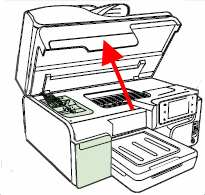
-
Look in the center of the printer for the four ink tubes that connect to the printhead, and then evaluate the ink tubes. The ink tubes should be bundled neatly, and they should not appear kinked or bent.
caution:
Do not touch, pull, or reposition the ink tubes. Just visually inspect them for kinks.Figure : Ink tubes, correctly bundled and not kinked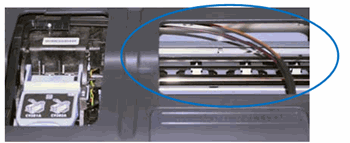
-
If the ink tubes are bundled correctly and are not kinked, continue to the next step.
-
If the ink tubes are bundled incorrectly but do not appear to be kinked, skip to Service the printer in this document.
note:
Incorrect bundling of the ink tubes does not directly cause print quality problems, but it is an issue that must be corrected. When the printer has been serviced, continue troubleshooting with the next step in this document. -
If the ink tubes are bundled incorrectly and are kinked, read the following list, and then skip to Service the printer in this document.When the printer has been serviced, replace the printhead associated with the kinked tubes:
-
If the black or yellow tube is kinked, replace the black and yellow printhead.
-
If the magenta or cyan tube is kinked, replace the magenta and cyan printhead.
-
-
Step 3: Evaluate Test Pattern 1
Evaluate Test Pattern 1 to make sure that the lines are straight and connected.
Figure : Example of Test Pattern 1
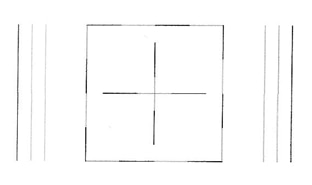
-
If the lines in Test Pattern 1 are straight and connected, go to the next step to evaluate Test Pattern 2.
-
If the lines in Test Pattern 1 are not straight and connected, follow these steps to align the printheads:
-
Load plain white paper into the tray.
-
On the control panel, touch the Right Arrow (
 ) to display the second navigation screen.
) to display the second navigation screen.
-
Touch Setup (
 ), and then touch Tools.
), and then touch Tools.
-
Touch Align Printer, and then touch OK. The alignment process begins.
-
Wait while the printer completes the alignment, and then touch OK.
-
Step 4: Evaluate Test Pattern 2
Evaluate the color blocks in Test Pattern 2.
Figure : Example of white lines in Test Pattern 2
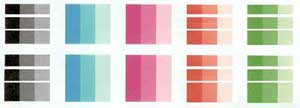
-
If there are white lines in any of the color blocks, follow these steps to clean the printheads.
-
Load plain white paper into the tray.
-
On the control panel, touch the Right Arrow (
 ) to display the second navigation screen.
) to display the second navigation screen.
-
Touch Setup (
 ), and then touch Tools.
), and then touch Tools.
-
Touch Clean Printheads. The printer cleans the printheads.
-
Wait while the printer completes the printhead cleaning process, and then touch OK.
-
Print another Print Quality Diagnostics Page.
-
If there are no defects on the report, stop troubleshooting.
-
If there are defects on the report, try another printhead cleaning.
-
If there are still defects on the report after another cleaning, skip to the solution in this document to replace one or both printheads.
-
-
-
If there are white lines through ALL the color blocks, and also white lines through the gray blocks in Test Pattern 3, then do not clean the printheads. Instead, continue to the next step to evaluate Test Pattern 3.
caution:Never turn off the printer when ink cartridges are not installed. To avoid issues that require cleaning the printhead or that can damage the ink system, always replace ink cartridges as soon as possible, and always turn off the printer using the Power button.
Step 5: Evaluate Test Pattern 3
Evaluate Test Pattern 3.
Figure : Example of lines and gaps in Test Pattern 3
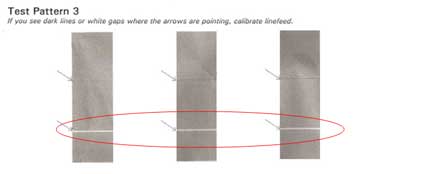
If any of the gray blocks show dark lines or white gaps where the arrows are pointing, follow these steps to calibrate the linefeed:
-
Load plain white paper into the tray.
-
On the control panel, touch the Right Arrow (
 ) to display the second navigation screen.
) to display the second navigation screen.
-
Touch Setup (
 ), and then touch Tools.
), and then touch Tools.
-
Touch Calibrate Linefeed. The printer calibrates the linefeed.
-
Wait while the printer completes the calibration, and then touch OK.
-
Print another Print Quality Diagnostics Page.
-
If there are no defects on the report, stop troubleshooting.
-
If there are still dark lines or white gaps in Test Pattern 3, skip to Service the printer in this document.
-
Solution five: Check the image
If you see no defects on the print quality diagnostic report, the print mechanism and ink supplies are working correctly. There is no reason to clean, align or calibrate, or to replace printheads or ink cartridges. Instead, try these solutions:
-
Recheck the first steps in this document. Many non-HP media could be incompatible with HP inks and printing systems. HP cannot guarantee the quality of non-HP inks.
-
Make sure that the image you are printing has sufficient resolution. Images that have been enlarged too much might appear fuzzy or blurry.
-
If the problem is confined to a band near the edge of a printout, use the software you installed with the product, or another software program to rotate the image 180°. The problem might not appear on the other end of the printout.

|
Windows only: If you are experiencing garbled, jumbled or illogical text, incomplete printouts, or missing text or graphics, go to Continuous Pages of Strange or Garbled Characters Print in Windows (c01954177).
|
Solution six: Replace one or both printheads
Follow these steps to replace one or both printheads.
If you have a defective cartridge or printhead, it might be under warranty. To check the warranty on your ink or toner supplies, go to Printer and Page Yield Overview, and then review the limited warranty information for your supplies.
Step 1: Determine which printhead is defective
If, after repeated printhead cleaning, the Print Quality Diagnostic page shows white lines across the color blocks in Test Pattern 2 (but no white lines in the gray blocks in Test Pattern 3), one or both of the printheads will have to be replaced. The Print Quality Diagnostic page shows which printhead should be replaced.
Look at the color blocks labeled Test Pattern 2. Some of them should show white horizontal streaks (if none of the blocks are streaked, the printheads are okay).
|
Figure : Streaked black, red, or green color blocks - replace Black/Yellow Printhead

|
|
Figure : Streaked cyan or magenta color blocks - replace Cyan/Magenta Printhead
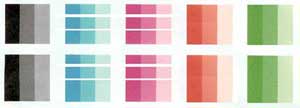
|
Step 2: Remove the defective printhead
-
Load plain white paper into the tray.
-
Open the carriage access door.Figure : Open the carriage access door

-
Touch Change Printheads on the printer control panel. The carriage moves to the access area on the left side of the printer. Wait for the carriage to stop moving.
-
Lift the printhead latch.Figure : Lift the printhead latch
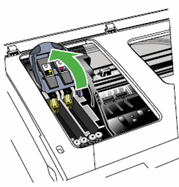
-
Lift the handle of the old printhead, and then use it to pull the printhead out of its slot.Figure : Remove the printhead
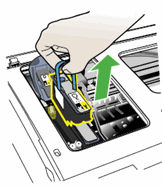
Step 3: Install the new printhead
-
Shake the printhead up and down at least six times while the printhead is still in its packaging.Figure : Shake the printhead six times
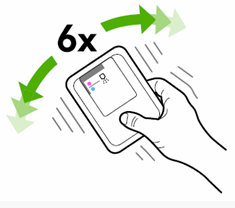
-
Remove the printhead from its packaging, and then remove the orange protective caps from the nozzles.Figure : Remove the printhead and the protective caps
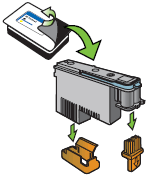
caution:
Do not touch the nozzles on the printhead. Touching the nozzles can permanently damage the printhead.Figure : Do not touch the printhead nozzles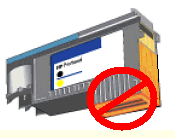
-
Insert the printhead into its color-coded slot. The label on the printhead must match the label on the printhead latch. Press down firmly on the printhead to ensure proper contact.
-
Insert the Black/Yellow printhead into the slot on the left.
-
Insert the Magenta/Cyan printhead into the slot on the right.
Figure : Insert the printhead into its slot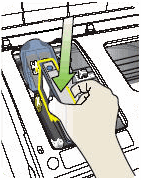
-
-
Repeat these steps if necessary to replace the other printhead.
note:
Make sure that you shake the other printhead back and forth six times before installing it. -
Pull the printhead latch all the way forward, and then press down to make sure that the latch engages. You might have to apply some pressure to engage the latch.Figure : Lower the printhead latch
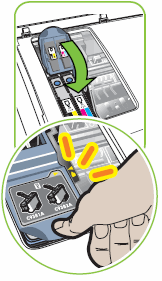
-
Close the carriage access door.Figure : Close the carriage access door
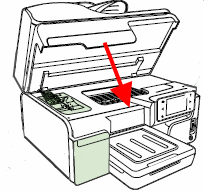
-
Wait while the printer aligns the printheads and prints an alignment page, and then touch OK.
-
Print another Print Quality Diagnostics Page. If Test Pattern 2 still displays white lines across the color blocks, continue to the next solution.
-
Check the Print Quality Diagnostics Page for any defects.
Solution seven: Service the printer
Service or replace your HP product if the issue persists after completing all the preceding steps.
Go to Contact HP Customer Support to schedule a product repair or replacement. If you are in Asia Pacific, you will be directed to a local service center in your area.
To confirm your warranty status, go to HP Product Warranty Check. Repair fees might apply for out-of-warranty products.
note:Keep a print sample that shows the problem. If the ink cartridges, printhead, or printer is replaced under warranty, the support agent will request the print sample. If the printer is returned to HP, the print sample must be returned with the printer. Place the sample in the output tray when you package your printer for shipping.
Enter a topic to search our knowledge library
What can we help you with?
Need Help?


